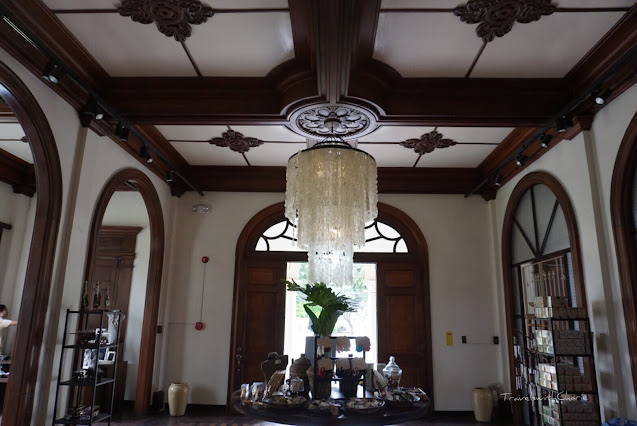 |
| Lizares Mansion |
The Lizares Mansion was built in 1937 by Don Emiliano Lizares for his wife, Concepcion Gamboa and five children. The family fled to safety when World War II broke out and the house was occupied by the Japanese military. The family returned to the house after the war but left once again after the demise of Don Emiliano. It was sold to the Dominican order in the 1960s and was converted in 1978 to a private school, Angelicum School. The mansion now houses the chapel. Andres Luna San Pedro was the architect of the mansion.
The school is not open to the public but it's possible to enter the grounds to get a close look at the mansion. Check with the guard who will ask you to leave your ID with him. MacArthur Drive, Tabuc Suba, Iloilo City
 |
| Joaquin Ledesma Mansion |
The Joaquin Ledesma Mansion is one of many impressive mansions in Jaro and a stone’s throw from the Jaro Cathedral. It has classical architectural features including Ionic style columns and pilasters. The balconies have distinctive balustrades which are repeated on the rooftop terrace. These balconies hearken to the good old days when families would sit outside to cool off in the early evening hours. Unfortunately, the mansion was destabilized due to earlier excavations done around the property in search of Japanese buried treasure. It is not open to the public.
Plaza Rizal Street, Jaro, Iloilo
Locsin Ancestral Mansion
The Locsin Ancestral Mansion is a well preserved house but is not open to the public. It is located beside Jaro Cathedral on Jalandoni Street. Casa Mariquit
Casa Mariquit is the oldest of the heritage houses in Iloilo. Built in 1803, it was the house of Maria Javellana whose nickname was Mariquit. She was the wife of the former Vice President of the Philippines, Fernando Lopez, who served during the Elpidio Quirino and Ferdinand Marcos administrations. Mariquit's father was a banker and he used the ground floor of the house for his banking operations.There is portrait of Mariquit on the wall in the living room of Casa Mariquit. The house though is a museum exhibiting memorabilia from the days when Lopez was Vice President including his desk. The most intriguing area of the house is the bedroom which displays the personal belongings of the Vice President.
Santa Isabel Street, Jaro, Iloilo
Yusay-Consing/Molo Mansion
The Yusay-Consing or Molo Mansion is now owned by one of the biggest department store chains in the country. The mansion now showcases Philippine handicrafts.Hardwood molding and carved rosettes that define the coffered ceiling add elegance to the foyer of the Molo Mansion. The Capiz shell chandelier is a new addition installed by the craft shop.
The Molo Mansion is in front of Molo Cathedral in Iloilo.
 |
| Camiña Balay nga Bato |
The living room above has a tin ceiling. Capiz shell windows add old world charm to the house.
The prayer room at Camiña shows a number of statuettes of saints on the altar. A few of these are nestled inside a wooden altar niche some of which are beautifully carved. These altar niches are sold at the store on the ground floor of the house as are many other antiques.
We were treated to thick, hot chocolate in a demitasse and cookies after the tour. This is included in the admission price of P150.00.
Villa Arevalo District, Iloilo City
Rafael Lopez Vito Mansion
Rafael Lopez Vito, a former Iloilo congressman, and his wife, Mariflor Jalandoni used to live here. The ground floor of the Lopez Vito Mansion is now occupied by a bank. The house is on a busy street in front of Jaro Park and next door to Jaro Cathedral. It is not open to the public.
Plaza Rizal Street, Jaro, Iloilo
 |
| Santa Barbara Church and Convent |
The Church and Convent of Santa Barbara was built between 1849 to 1878. The Revolutionary Government in the Visayas under Martin Teofilo Delgado used the property as their headquarters in 1898. It was declared a National Historical Landmark in 1990 by the National Historical Commission of the Philippines and a National Cultural Treasure in 2013 by the National Museum of the Philippines.
The convent and church were both recently restored. The original hardwood floors in this hallway and in the other chambers are well preserved. Note the thick walls which are reminiscent of Romanesque architecture. Life-size statues of saints are displayed in one of the rooms. The balcony offers a pretty picture of the town plaza but watch out for the fragile floors. The choir loft of the church is accessible from the convent and has an unobstructed view of the interior of the church.
Entrance to the convent is free. Santa Barbara Church and convent are in the center of Santa Barbara and right across from the plaza.
Where to stay:
Seda Hotel
Donato Pison Avenue, Mandurriao, Iloilo City
sedahotels.com
*****
Images by TravelswithCharie







